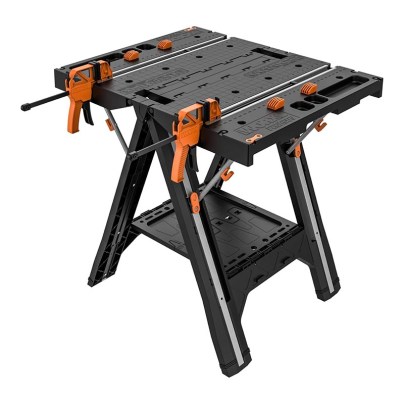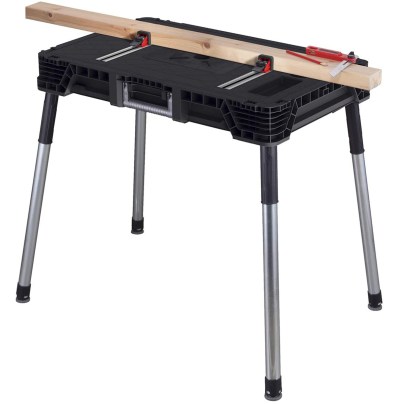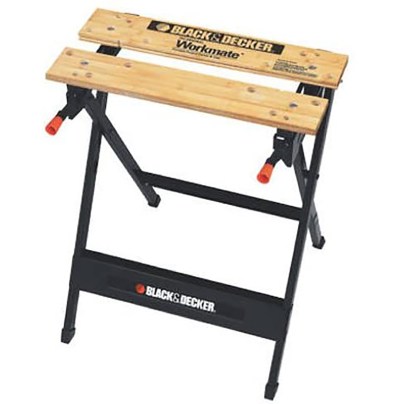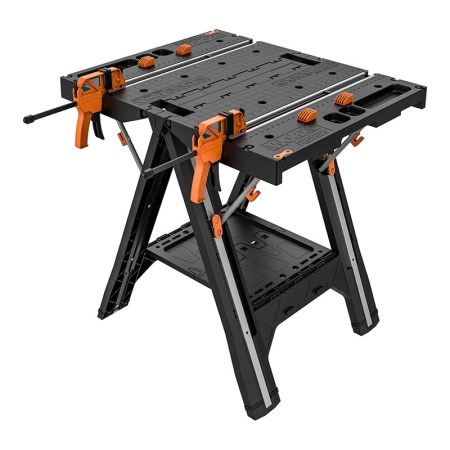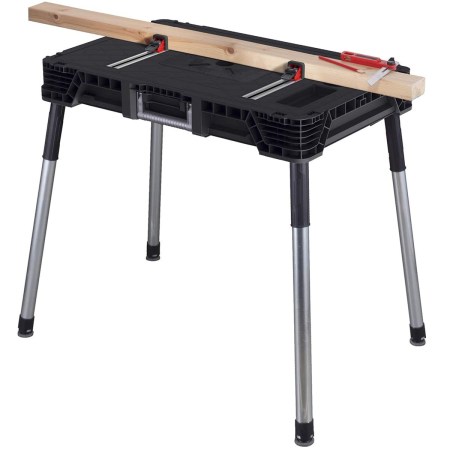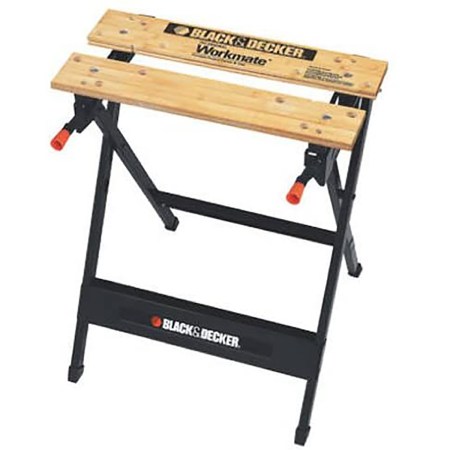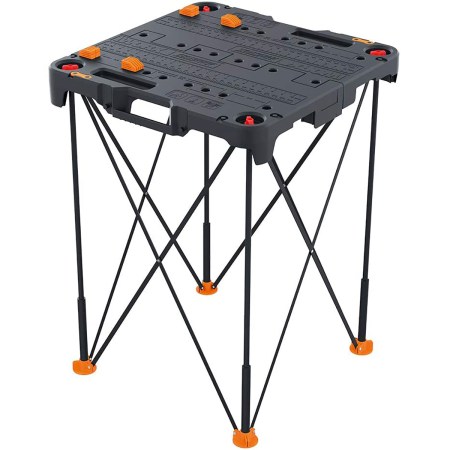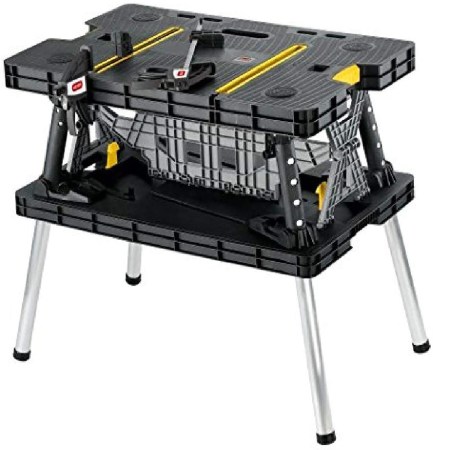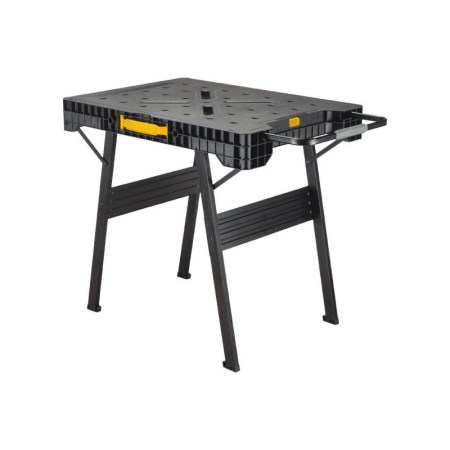We may earn revenue from the products available on this page and participate in affiliate programs. Learn More ›
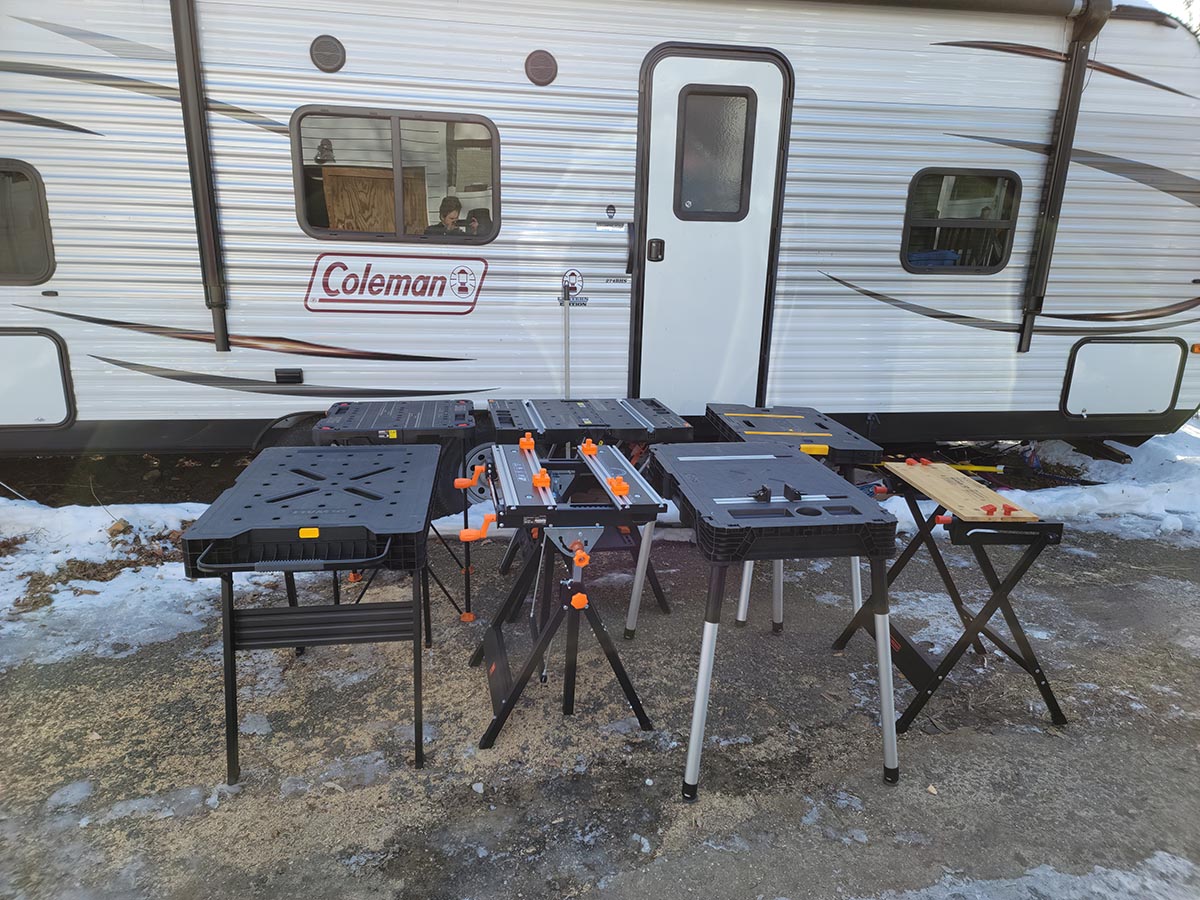
Whether it’s for use as a stable work surface at a job site or to address a lack of room for a permanent shop, a portable workbench is an invaluable partner when working on a project.
These nifty assistants are capable of handling weights of up to 1,000 pounds, yet they’re light enough to carry from place to place. Portable workbenches serve as an extra set of hands, with clamping systems that hold lumber, metal pipes, and other materials firmly in place. When the job is over, these workbenches fold flat for easy transport and storage.
When shopping for a portable workbench, there are certain factors to consider before making a final purchase. And, to make the process of buying the best portable workbench even easier, we performed hands-on testing with several models. Some excelled, while others didn’t make the grade.
- BEST OVERALL: Worx Pegasus Folding Work Table & Sawhorse
- RUNNER-UP: Keter Jobmade Portable Work Bench and Miter Saw Table
- BEST BANG FOR THE BUCK: Black+Decker Workmate Portable Workbench
- BEST COMPACT: Worx WX066 Sidekick Portable Work Table
- BEST HEAVY-DUTY: Keter Folding Table Work Bench
- BEST FOR SANDING: DeWalt Express Folding Workbench
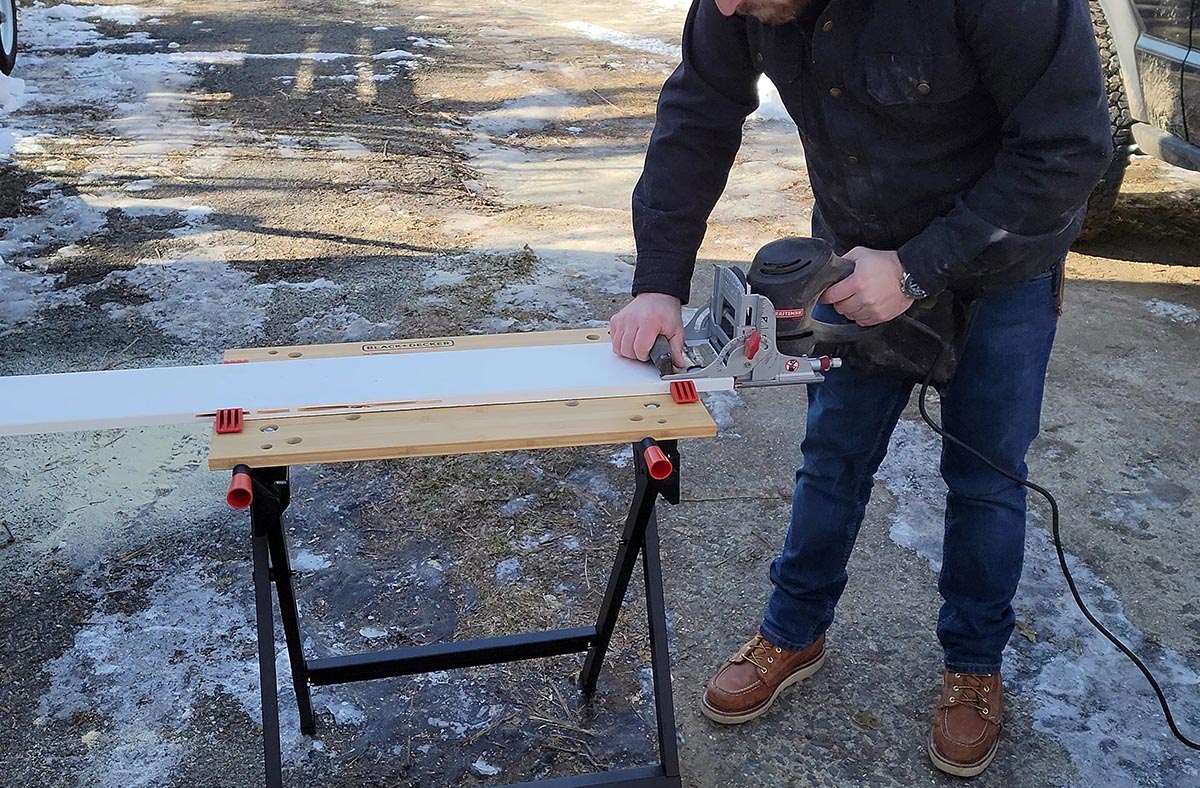
How We Tested the Best Portable Workbenches
Testing workbenches can be a lot of fun, and we did our best to truly put these models through the paces.
First, we assessed assembly and setup. We wanted to make sure that each bench was really as portable as it claims. We set them up, broke them down, and moved them around to assess their weight and ease of use. Next, we set them up and used each of them as a miter saw stand and grinding surface, assessing how stable they were with the saw running and our weight over the boards. Finally, we used the jaws or clamps to hold a workpiece in place, prying on the boards to see how well the clamps would hold. We even set up the biscuit joiner to test how well they hold pieces under force.
Between those tests, which replicate what a typical DIYer or contractor might put these workbenches through, we had a good idea of what they could offer.
Our Top Picks
The following products feature rugged construction, excellent clamping features, and compact designs that make them easy to carry or store. And, to make sure that we’re only suggesting the best portable workbenches, we performed hands-on testing with each of the following models. Find out which models are top-tier and which workbench didn’t make the cut.
Best Overall
Worx Pegasus Folding Work Table u0026 Sawhorse
See ItProduct Specs
- Work surface dimensions: 31 inches long by 25 inches wide
- Materials: ABS plastic
- Weight: 30 pounds
Pros
- No assembly is required at all; great for quick odd jobs or transporting if necessary
- Comes with built-in, high-quality clamps and dogs for reliability while in use
- Dual purpose; works as a sawhorse or a table
Cons
- No built-in carry handle; can be awkward to transport
With its lightweight adjustability for various applications and sturdy build, the Pegasus from Worx is an excellent option for DIYers with space limitations or a pro working at a remote job site. This workbench, made of high-grade plastic with lockable legs, can support up to 300 pounds when in work table mode. A set of quick clamps and holding clamps that work with two T-strips integrated into the benchtop provide ample clamping power for large dimensional lumber.
True to its name, the Pegasus can fold its “wings” down, allowing it to morph into a sawhorse that can hold up to 1,000 pounds. The underside of this workbench features a small storage area for supplies or a power strip. When folded, this workbench measures just 5 inches thick, making it easy to throw into the back of a vehicle despite weighing 30 pounds.
First, let’s point out that the Pegasus requires absolutely zero assembly, and that’s an incredible benefit compared to other models. It was a breeze to set up and break down, and the sliding latches that secure the wings are a brilliant design. We also liked that it came with built-in clamps that store away under the wings (they were the best clamps in the test) and bench dogs to hold workpieces in place. We also liked that we were able to link this table to other Worx tables, providing a longer work surface. Also, popping the wings down to use this workbench as a sawhorse is a breeze. Our only complaint is that it should have a carrying handle at 30 pounds.
Read our full review: Worx Pegasus Folding Work Table & Sawhorse
Get the Worx Pegasus Folding Work Table & Sawhorse at Amazon, The Home Depot, or Worx.
Runner-Up
Keter Jobmade Portable Work Bench and Miter Saw Table
See ItProduct Specs
- Work surface dimensions: 34½ inches by 21¾ inches
- Materials: ABS plastic and aluminum
- Weight: 20 pounds
Pros
- Lightweight design is easy to tote around a worksite or transport in a vehicle
- Space-saving, secure leg storage is great for tight spaces
- Keeps a sturdy hold on the saw during use
Cons
- No squeeze clamps included; need to purchased separately
The portable Jobmade workbench from Keter offers a sturdy, lightweight design with integrated locks for legs and built-in tool storage. Boasting an integrated clamping system with four separate clamps, this portable workbench from Keter holds materials firmly in place so you can cut, drill, hammer, or assemble projects. The workbench surface includes two metal rails that receive 2-inch bar clamps, making it easy to clamp workpieces. Built-in leg stabilizers keep the table level and in place as you work.
This workbench uses durable resin construction for the worktop with sturdy aluminum legs, giving it a 1,000-pound capacity. Other features include
. This lightweight table also has the ability to collapse into a briefcase shape complete with a handle.
The Keter Jobmade Portable Work Bench was a breeze to use. The legs snapped up inside the table with a smart, space-saving design, and they lock in securely, making carrying this workbench by the handle drama-free. Also, the built-in storage box under the table is nice, but it’s the table clamps that we really liked as they were secure enough to hold a saw in place (though workpieces could benefit from squeeze clamps).
Get the Keter Jobmade Portable Workbench at Amazon.
Best Bang for the Buck
Black+Decker Workmate Portable Workbench
See ItProduct Specs
- Work surface dimensions: Adjustable, but a max of 24 inches by 13¾ inches
- Materials: Wood, metal, and plastic
- Weight: 15 pounds
Pros
- Very lightweight and compact design; stores easily in small spaces or the trunk of a vehicle
- Once assembled, it’s easy to use; simple design is ideal for newcomers and professionals alike
- Built-in, warp-resistant vise jaws worked well under pressure
Cons
- Assembly was a nightmare; lots of plastic parts to put together
With a large vice that can handle various shapes and sizes, the Black & Decker Workmate Portable Workbench is an excellent option for professionals and DIYers.
The Black & Decker Workmate has provided a mobile work surface for weekend warriors and pros alike since its debut in the 1970s. Much of its design remains the same today. The Workmate retains its classic foldable metal frame and wide-set legs, which create a rock-solid base. The hardwood work surface doubles as a sizable and versatile vice capable of gripping large pieces. With its rotating pegs and dual handle controls, the vice can be angled to grip irregular-shaped objects.
The Workmate’s benchtop features two height positions to suit a variety of projects. Its sturdy, heavy-gauge steel frame gives it a maximum capacity of 350 pounds, while rubber feet keep this workbench firmly in place. When the workday is over, this portable unit, weighing 15 pounds, folds flat for easy transport.
Let’s start out with our big complaint: Assembling this workbench was a nightmare, and quite a bit of the bench is plastic. But, once assembled, it actually worked really well. The built-in jaws were secure, and we liked that it was incredibly lightweight (just 14 pounds!). It’s probably not the most durable model on the list, but for the price, the Black & Decker Workmate has a lot to offer.
Get the Black+Decker Workmate at Amazon or Walmart.
Best Compact
Worx WX066 Sidekick Portable Work Table
See ItProduct Specs
- Work surface dimensions: 24 inches by 24 inches
- Materials: ABS plastic and steel
- Weight: 12.6 pounds
Pros
- Surprisingly stable for the 12.6-pound weight; quality bench dogs are built-in
- Work surface full of measurements and references; ideal for most projects
- Can link to other Worx tables to create a larger work area
Cons
- No squeeze clamps included; may not be ideal for some users’ preferences
This portable workbench from Worx weighs only 12.6 pounds, allowing users to carry it from workshop to yard for an outdoor project or throw it in the truck for a trip to the worksite.
A high-grade yet lightweight plastic benchtop holds up to abuse. Steel metal legs with rubber feet provide a sturdy nonslip base that can hold up to 300 pounds. The benchtop features four pegs to allow for easy clamping and handy guides molded into the surface for taking measurements. True to its name, two Sidekicks can link together to make a larger table or be connected to Worx’s larger Pegasus portable workbench.
The Worx Sidekick quickly became one of our favorite models in the test. First, we liked that despite an unorthodox two-piece (legs and work surface) design, it was easy to set up and quite stable. Also, the work surface is full of measurements and references for better workflow. We also like that we could link this to other Worx tables and that the included bench dogs were of the highest quality in the bunch. Our only moan is that this model doesn’t come with or receive squeeze clamps.
Get the Worx Sidekick at Amazon, The Home Depot, or Walmart.
Best Heavy-Duty
Keter Folding Table Work Bench
See ItProduct Specs
- Work surface dimensions: 21½ inches by 33½ inches
- Materials: ABS plastic and aluminum
- Weight: 27 pounds (though it might feel a little heavier)
Pros
- Heavy-duty weight capacity; can hold up to 1,000 pounds of material
- Very easy to set up; takes just 30 seconds to unfold
- Built-in clamps and shelf for ample storage and versatility
- Sturdy, compact design can be folded down into a 4.4-inch thick unit
Cons
- Guides for clamps are a bit finicky; may not have the durability of some comparable options
For heavy-duty jobs, a workbench that can endure the rigors of a pro job site while still being lightweight enough to transport is a must. This portable workbench from Keter weighs just 27 pounds, yet it boasts an impressive 1,000-pound weight capacity, making it an excellent option for professional job sites.
This formidable workbench features heavy-duty resin construction and aluminum legs that provide plenty of strength. Two 12-inch clamps secure material to the workbench, which features an ample worktop of 33 inches by 22 inches. When the job is complete, it folds into a 4.5-inch-thick flat suitcase shape, complete with an ergonomic handle for easy transport.
We need to come clean about something: We’ve been using this workbench for everything from camera gear to a saw stand for a while now, and if it didn’t fit the “heavy-duty” award so well, it might’ve been our best overall. This table features a 1,000-pound weight capacity yet is very easy to set up, with legs that stow away inside. We liked the built-in clamps and the lower shelf for its convenience, but the compact design also makes it easy to stow away. The biggest benefit is that it’s rock-solid in use, despite not having nonslip feet. If there’s room for improvement, it’s that the clamp guides aren’t as smooth or easy to use as we’d like.
Get the Keter Folding Table Work Bench at Amazon or Walmart.
Best for Sanding
DeWalt Express Folding Workbench
See ItProduct Specs
- Work surface dimensions: 33 inches by 24 inches
- Materials: ABS plastic and steel
- Weight: 25 pounds
Pros
- Sturdy construction can hold up to 1,000 pounds of materials and tools
- Very easy to set up; great for quick DIY projects or job sites
- Lots of holes for clamps, dogs, and cleaning the surface
Cons
- Not quite as stable as we’d like
- No clamps or dogs included with purchase
While most workbenches feature complicated tracks for squeeze clamps or bench dogs, this model from DeWalt takes a more streamlined approach. While being capable of handling up to 1,000 pounds, it also has several holes that serve as well for sawdust management as they do clamps and bench dogs. Made from ABS plastic and steel, this model unfolds and sets up quickly, and the 33-by-24-inch work surface offers plenty of room for work.
During testing, we noticed a few things. First, this is truly a heavy-duty model from a brand we know and trust. Also, it’s lightweight and easy to set up, and clearing the work surface of sawdust and shavings is as simple as a quick sweep. If there are any complaints, it’s that this table might not be as stable front to back as we’d like. Also, it didn’t come with any bench dogs or clamps, which seemed strange compared to the other models we tested.
Get the DeWalt Express Folding Workbench at Ace Hardware or The Home Depot.
ALSO TESTED
WEN Height Adjustable Tilting Work Bench
Wen’s one of our favorite affordable tool brands, but this one really let us down. The materials used were top-notch, and the design seemed brilliant—at first. We did have to assemble it (which was a pain), but that’s not why it performed so poorly.
This work table features clamping jaws with locking tabs to adjust the stationary jaw, allowing the user to quickly adjust the position for clamping. While the left clamp worked flawlessly, the right clamp did not lock in place at all. In fact, we took this workbench apart and reassembled it to see what the issue might’ve been, but it did not lock. While it could be a good deal for the price, it’s useless without securely locking jaws.
Jump to Our Top Picks
What to Consider When Choosing a Portable Workbench
A portable workbench should be lightweight and durable, and it should have the features to assist with a number of projects. After all, a portable workbench’s most desirable feature should be versatility. Keep the following considerations in mind while shopping for one of these tools.
Size and Weight
When shopping for a portable workbench, size and weight are crucial. Most portable workbenches weigh less than 30 pounds, which is a manageable weight for one person. Some workbenches weigh as little as 15 pounds, though 25 to 30 pounds is the most typical weight range.
Some portable workbenches fold flat to between 4 and 7 inches thick to allow for easy transport and storage. When set up, most portable workbenches have worktops that are approximately 30 inches long by 24 inches wide and stand about 30 inches off the ground, but this varies by model.
Material
Portable workbenches should be sturdy enough to endure abuse but also light enough to transport. To achieve this balance, most workbenches are made of a combination of sturdy steel and lightweight ABS plastic or wood. Some portable workbenches feature steel or aluminum legs that provide a sturdy support system with a benchtop of heavy-duty plastic resin or a lighter wood such as bamboo.
Stability
When working on a project, a wobbly surface just won’t do, so a portable workbench must be sturdy. Portable workbenches feature wide-set feet with steel or aluminum legs that help provide stability. Look for a portable workbench with feet coated in rubber or some other nonslip material to prevent the bench from sliding.
Clamping
Most portable workbenches feature integrated clamping systems. While some portable models have entire benchtops that open to clamp large material, others integrate tracks into the worktop to incorporate holding clamps and large 2-inch bar clamps. These clamps are designed to secure large pieces of wood or metal, allowing the user to cut, sand, or fasten materials.
Additional Features
Many portable workbenches include special features to make life easier. For example, some workbenches are designed with molded handles to make transport easier, whereas others may include measurement markings printed or molded onto the worktop surface. Still other models feature extra pockets and drawers for tool storage, while some even have integrated power strips.
Adjustability and Versatility
Portable workbenches are designed to meet a variety of demands, and versatility is their greatest benefit. Some workbenches may double as workstations for miter saws, while others have the ability to change shape completely, allowing them to function as both a workbench and sawhorse.
Many workbenches allow users to change the worktop’s height by up to 4 inches, which is handy when using the workbench with a table saw or as a support for cutting longer material. Other styles allow users to change the angle of the workbench to use as a fence for cutting.
FAQs
If you’re wondering which qualities to look for in a workbench, keep reading for some of the most frequently asked questions about the top portable workbenches.
Q. What makes a good portable workbench?
A quality portable workbench should be durable enough to handle the rigors of a home workshop or pro job site. It should have a sturdy base that prevents it from wobbling while you work. It should include clamping features to hold materials securely in place. A portable workbench also should break down in seconds into a shape that’s compact and light enough for one person to manage.
Q. What’s the optimal height for a workbench?
Unlike dining room tables or kitchen counters, no standard workbench height exists. Workbench heights can range from 28 inches to 38 inches. Workbench heights on the high end are suitable for assembling items and to function as outfeed tables for table saws, while lower workbench heights allow for more leverage for such jobs as sanding. If you’re not sure which height you need, use this literal rule of thumb—the benchtop should meet the same level as the knuckle in your thumb when standing with your arms hanging at your sides.
Q. How much weight can a portable workbench handle?
The weight capacity of workbenches varies. Lighter-duty workbenches can handle a weight of around 250 pounds, which is adequate for most home workshops, while a heavy-duty workbench may have a weight capacity as high as 1,000 pounds.
Q. How long does a portable workbench last?
Most portable workbenches use plastic in their design. While this makes them much lighter than a permanent workbench, plastic isn’t as durable as wood or steel. Plus, portable workbenches have movable joints that allow them to collapse, making them weaker than a standard workbench with no moving parts. With that in mind, most portable workbenches should last many years when properly maintained.
Why Trust Bob Vila
Bob Vila has been America’s Handyman since 1979. As the host of beloved and groundbreaking TV series including “This Old House” and “Bob Vila’s Home Again,” he popularized and became synonymous with “do-it-yourself” home improvement.
Over the course of his decades-long career, Bob Vila has helped millions of people build, renovate, repair, and live better each day—a tradition that continues today with expert yet accessible home advice. The Bob Vila team distills need-to-know information into project tutorials, maintenance guides, tool 101s, and more. These home and garden experts then thoroughly research, vet, and recommend products that support homeowners, renters, DIYers, and professionals in their to-do lists.
Meet the Tester
Tom Scalisi is a full-time DIY and construction writer for many of the largest websites in the industry, including BobVila.com, This Old House, Family Handyman, and Forbes. He also owns and operates a pest control blog, RiddaBugs.com.
Additional research provided by Tony Carrick.
